Changes to ATF eForms are Underway – Now to be Called FEAM
eForms Changing to Firearms and Explosives Application Module (FEAM)
Liason says system wont be ready in time to demo at SHOT Show
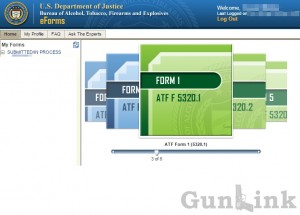 As a BATFE eForms valued customer (what, you don’t have your frequent buyer’s card?), we received an update email today to notify us about some changes that are coming in the system.
As a BATFE eForms valued customer (what, you don’t have your frequent buyer’s card?), we received an update email today to notify us about some changes that are coming in the system.
The first change that you will notice is the name. No longer will it be called “eForms.” Rather, it will go by the new moniker of “Firearms and Explosives Application Module (FEAM)”. This change, the BATFE says, is to emphasis that FEAM is more than a “fillable form”.
A Business Process Module
The advisory maintains that, instead of just being a form, the system is a “business process module” and gives a list of minimum the functionalities, listed below. Although it doesn’t explicitly say as much, reading between the lines might lead one to believe that the changes are, in part, to pave the way to accommodate (or not) the requirements of ATF 41F (nee 41P). It also sounds like they may be scrapping all of that hard work that they had been promising was underway toward the reboot of the eForms Form 4 functionality.
- Auto assignment – All applications will be immediately upon submission assigned to an examiner for processing. I’m not sure if this is a good thing or a bad thing. It seems like it could slow down some applications if it immediately goes onto the desk of a slow or grumpy examiner versus working its way through the queue to land on the first available desk.
- Auto approval – Some forms, like the ATF Forms 2 and 3, if they meet certain pre-determined criteria will be automatically approved by the FEAM system upon submission. This generally sounds like a good thing, as it could cut down on the amount of time buyers spend waiting for custom-built NFA items to hit the registry from the manufacturer or for the transfer to their local dealer to go through so they can start waiting on their Form 4.
- Internal controls and performance measurement reporting – ATF has a full audit trail of every application received with date and time stamps for every step in the process. Digital signatures can be used to lock down portions of the form to ensure the security of the data and the authenticity of the submitter.
- Improved business processes with automatic Records Management & Retention, as mandated by the Office of Management and Budget.
- Electronic Signature (for submitter and ATF personnel) – provides enhanced authentication, validation and improves processing and approval. From an individual viewpoint, this doesn’t sound like that meaningful of a change; particularly barring the absence of a mechanism for users to submit fingerprints and photos – which will soon be required for all non-SOT users.
- Enhance Industry satisfaction: user-friendly interaction. Aww, look… the BATFE is humble. To be honest, the eForms interface couldn’t have got much worse. It looked like a hello world website from the ’90s. But it suited its purpose as an online fillable form.
- FEAM provides the Application Program Interface (APIs) needed to update the existing ATF back end databases, to allow for the batch submission of multiple forms using one computer session. Yahtzee. Bulk forms.
- Improves efficiency for the Enforcement Programs and Services staff – Forms can be automatically routed, evaluated and tracked so that final determinations can be made in a consistent and expeditious manner.
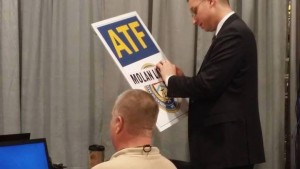 The advisory also indicates that they had anticipated being able to demo FEAM v1.0 at SHOT Show this upcoming week, but – shockingly – they didn’t have it done in time. Drats! We had hoped to see something good when we stopped by their show booth this year.
The advisory also indicates that they had anticipated being able to demo FEAM v1.0 at SHOT Show this upcoming week, but – shockingly – they didn’t have it done in time. Drats! We had hoped to see something good when we stopped by their show booth this year.
We had hoped to be able to present the first iteration of FEAM at the 2016 SHOT Show. ATF performed an assessment of what was contracted to be developed for FEAM and what the contractor planned to deliver. At the end of the assessment, all parties involved felt that the product outlined in the current contract did not fully provide all the functionality that we expected, or that the industry requested. For these reasons we decided that rather than to continue on the current course, we would take the steps listed below to ensure that FEAM is a worthwhile investment for both the industry and ATF:
- Curtail the current development effort.
- Determine what is needed to sustain the existing eForms system, until the full requirements for FEAM can be determined and developed.
- Make the necessary changes to eForms to stabilize the infrastructure with the ever-increasing user population.
- Determine if we can re-introduce the Form 3 to the current eForms, through load testing and other system validations.
- Perform an assessment of the ATF and industry requirements for FEAM.
- Secure required funding for a new FEAM initiative, based on the revised requirements.
- Restart the FEAM initiative, to include industry participation during the requirements gathering and testing processes.
We look at this as only a minor delay. It is our intention to use this delay to acquire the tools and resources necessary to develop a product that will provide more functionality and a stable workflow process and infrastructure. All the work previously done on FEAM is not lost. It will be the foundation for the work that is yet to come.
BOHICA: 41F (nee 41P) is Here
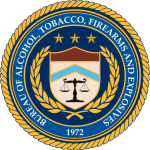 Attorney General Lynch Signs Off 41P Final Ruling. It WILL Happen in as little as 180 days.
Attorney General Lynch Signs Off 41P Final Ruling. It WILL Happen in as little as 180 days.
Included in the president’s inappropriately named “New Executive Actions to Reduce Gun Violence and Make Our Communities Safer” is the official harbinger of the BATFE’s 41P rule change.
Despite NFA owners being among the most law abiding gun owners who already have to jump through the most hoops, and despite the fact that – on average – NFA firearms are pretty much never used in crimes, the president’s edicts makes it more difficult to purchase what he calls “some of the most dangerous weapons and other items” through a trust, corporation, or other legal entity.
This change will require fingerprints, photographs, and background checks for all “responsible persons” of the trust or other legal entity. It is unclear what this change will do to the ability for legal entities to use the eForms system, which the BATFE claims to have been spending considerable time and resources on improving and getting the broken eForms Form 1 functionality working again, as the system appears to have no mechanism for accepting photographs or fingerprint or information.
Attorney General Loretta Lynch describes the change as “[closing] the ‘trust loophole’ that people have been using to avoid registering by going through legal trusts, corporations or other legal status.” And – in case this is confusing for some – by “loophole,” AG Lynch means “the law as written.”
Lynch signed off on the rule making and the official BATFE announcement is here. The release states that rule 41P “is effective 180 days after date of publication in the Federal Register,” which can be at any time now. It is unclear whether the BATFE will ever respond, as required, to the 9,000+ comments received regarding the rule change with anything other than “who cares, the president has a pen and a phone.”
41P Final Ruling Summary:
The Department of Justice is amending the regulations of the Bureau of Alcohol, Tobacco, Firearms, and Explosives (ATF) regarding the making or transferring of a firearm under the National Firearms Act (NF A). This final rule defines the term “responsible person,” as used in reference to a trust, partnership, association, company, or corporation; requires responsible persons of such trusts or legal entities to complete a specified form and to submit photographs and fingerprints when the trust or legal entity files an application to make an NFA firearm or is listed as the transferee on an application to transfer an NFA firearm; requires that a copy of all applications to make or transfer a firearm, and the specified form for responsible persons, as applicable, be forwarded to the chief law enforcement officer (CLEO) of the locality in which the applicant/transferee or responsible person is located; and eliminates the requirement for a certification signed by the CLEO. These provisions provide a public safety benefit as they ensure that responsible persons undergo background checks. In addition, this final rule adds a new section to ATF’ s regulations to address the possession and transfer of firearms registered to a decedent. The new section clarifies that the executor, administrator, personal representative, or other person authorized under State law to dispose of property in an estate may possess a firearm registered to a decedent during the term of probate without such possession being treated as a “transfer” under the NF A. It also specifies that the transfer of the frrearm to any beneficiary of the estate may be made on a tax-exempt basis
NFA Rule Change Receives Top Billing in BATFE Portion of Federal Regulatory Agenda
The Introduction to the Unified Agenda of Federal Regulatory and Deregulatory Actions was published today in the Federal Register, and it contained what may be a telling excerpt regarding BATFE’s proposed rule 41P. The Unified Agenda is essentially the roadmap for regulatory planning throughout the coming year. According to the publication’s summary, the document is meant to “identify regulatory priorities and provide additional detail about the most important significant regulatory actions that agencies expect to take in the coming year.” Obviously, one agency in particular is of special interest around here: The Bureau of Alcohol, Tobacco, Firearms, and Explosives – or BATFE.
The Unified Agenda is a massive document, spanning 206 pages in PDF format. Among those 206 pages, the BATFE’s “important significant regulatory actions” that have been identified as top priorities occupies two paragraphs. Of those two paragraphs, the first – after a brief introduction of the BATFE – is dominated by discussion of the proposed rule 41P while everything else the BATFE plans to do for the next regulatory period is stuffed into the second paragraph:
Bureau of Alcohol, Tobacco, Firearms and Explosives (ATF)
ATF issues regulations to enforce the Federal laws relating to the manufacture and commerce of firearms and explosives. ATF’s mission and regulations are designed to, among other objectives, curb illegal traffic in, and criminal use of, firearms and explosives, and to assist State, local, and other Federal law enforcement agencies in reducing crime and violence. The Department is planning to finalize a proposed rule to amend ATF’s regulations regarding the making or transferring of a firearm under the National Firearms Act. As proposed, this rule would (1) add a definition for the term “responsible person”; (2) require each responsible person of a corporation, trust or legal entity to complete a specified form, and to submit photographs and fingerprints; and (3) modify the requirements regarding the certificate of the chief law enforcement officer.
ATF will continue, as a priority during fiscal year 2016, to seek modifications to its regulations governing commerce in firearms and explosives. ATF plans to issue regulations to finalize the current interim rules implementing the provisions of the Safe Explosives Act, title XI, subtitle C, of Public Law 107-296, the Homeland Security Act of 2002 (enacted Nov. 25, 2002). ATF also has begun a rulemaking process that will lead to promulgation of a revised set of regulations (27 CFR part 771) governing the procedure and practice for proposed denial of applications for explosives licenses or permits and proposed revocation of such licenses and permits.
Note that this still does not mean that the BATFE is finalizing plans to implement the proposed rule. As we previously reported, BATFE received approximately 9,500 comments about the proposal, each of which must be addressed before making a decision. Resources working on 41P may have been diverted to perusing some of the 310,000 or so comments received regarding the M855 ammo ban which must, likewise, be read and responded to.
It may well be that 41P is at the top of BATFE’s priority list simply to clear it from their docket, as they did with the “green tip ban,” and move on to other issues. While it may not be much of an update, and firearms owners’ only recourse may still be to just “wait and see,” at least there is some indication that something is happening somewhere, and someone may be looking into it.

ATF 41P Minor Update – Up to One Month Pushback
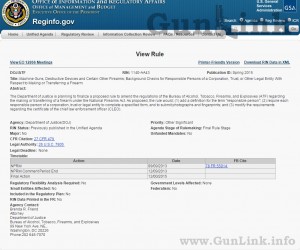 Two years to the day after the comment period – which received well over 9,000 comments – ended, there is still little news other than that the Bureau of Alcohol, Tobacco, Firearms, and Explosives (BATFE) has amended the rule 41P status to reflect yet another pushback of up to one month.
Two years to the day after the comment period – which received well over 9,000 comments – ended, there is still little news other than that the Bureau of Alcohol, Tobacco, Firearms, and Explosives (BATFE) has amended the rule 41P status to reflect yet another pushback of up to one month.
The 41P status page has been again updated to reflect a mysterious final action date of 01/00/2016 from the previously noted and equally curious 12/00/2015 final action date. It should again be pointed out that this date is the date by which the BATFE will make a decision on whether or not to implement the changes set forth in the proposed rule, not necessarily the date by which the rule takes effect – if it is ever approved and takes effect at all.
Joshua Prince’s law blog posted on the topic last month with several important notes and some speculation about the potential future of the rule. Prince postulates that “ATF could move forward with a final rule prior to the end of this year or ATF could once again delay the final action date; however, if it is delayed further, it will likely be delayed in one month increments.” Further, he points out the following two important statements from BATFE personnel:
- The Agency Contact, Brenda Friend Esq., previously told Attorney Merting that the rule would not be retroactive and would only apply to new transactions.
- During the 12th Annual Import/Export Conference, I asked ATF howpending transfers would be treated, if a new rule was implemented. ATF responded that any new regulation would only apply to applications submitted after the effective date of the regulation. Attorney Merting confirmed that this was consistent with what Attorney Friend told him.
In essence, it is more of the same wait-and-see that we have had for the last two years.
As always, the GunLink Blog will post additional details as they become available.
BATFE 41P – No News is…. No News
 As we get closer and closer to the theoretical “12/00/2015” final action date for the ATF’s Rule 41P – the rule that would make it more difficult to make or transfer NFA items to a gun trust – there hasn’t been much chatter about it. This includes the absence of a reply to the 9,500 or so comments that were submitted during the comment period that must be responded to. Prince Law reported in August that there were four reviewers working through those comments.
As we get closer and closer to the theoretical “12/00/2015” final action date for the ATF’s Rule 41P – the rule that would make it more difficult to make or transfer NFA items to a gun trust – there hasn’t been much chatter about it. This includes the absence of a reply to the 9,500 or so comments that were submitted during the comment period that must be responded to. Prince Law reported in August that there were four reviewers working through those comments.
This year saw, once again, renewed pushes for more gun control that fell flat and served to do little other than rally support against such gun control measures. Anti-gun zealots were, once again, caught cooking the books to get false numbers that they spread as gospel and telling outright lies. This, along with mainstream media coverage of the danger of “gun free zones” this year may even be awakening some of the general public to the utter nonsense that is the gun control agenda.
That turning tide of Second Amendment proponents away from being “the silent majority” is a great thing to see. Some of the delay in 41P movement is said to have been a result of the government resources that had to be devoted to reading the more than 300,000 comments on the armor piercing ammunition regulations (which were ultimately scrapped because “we spoke, they listened“).
Note that this mythical zeroth day of December cited on the Rule 1140-AA43 page is not given as an effective date for 41P. It is the current “final action” date, upon which they will decide whether to scrap this ruling, as they did with the ammo ban, or go with it.
Public sentiment aside, there is also the question of political sentiment. Second Amendment rights are again becoming a hot topic that is finding its way into the media’s political spotlight, to include presidential debates. Add to that the fact that there is legislation introduced that will weaken the NFA’s grip on silencers rather than tighten it, as 41P would do. HR3799 is drawing congressional support with 17 Representatives from 14 states cosponsoring the bill.
In other congressional news, HR3799 co-sponsor Rep. John Carter (R-TX) proposed an amendment to the FY16 appropriations bill, HR2578, which would neuter 41P. H.Amdt 320, which prohibits funds made available by the appropriations bill from being “used to propose or to issue a rule that would change the Chief Law Enforcement Officer certificate requirement in a manner that has the same substance as the proposed rule published on September 9, 2013” was agreed to by a voice vote the day before the bill passed the House. However, H.Amdt 320 – as Sec. 548 in the 6/8/2015 version referred in Senate – appears to be struck from the 6/18 version reported with amendment to Senate.
In sum, nobody still knows when anything will happen or, if and when it happens, what it will be. Nobody knows if 41P will die on the vine, be dropped altogether, or picked up and run with. Nor, if it is the latter, does anyone know how such a scheme would be implemented, what would (or would not) be grandfathered, what would happen to submitted applications in the processing queue, etc. At least, if they do know, they aren’t telling.
Support HR 3799 to Remove Silencers from NFA
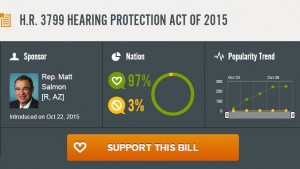 As announced last week, a new bill has been introduced in the House to “provide that silencers be treated the same as long guns.” That is, to essentially remove them from the purview of the National Firearms Act of 1934 (NFA) and ease the cumbersome process of acquiring one of these valuable safety devices – a process that involves a lengthy wait and a $200 tax on top of the cost of the device.
As announced last week, a new bill has been introduced in the House to “provide that silencers be treated the same as long guns.” That is, to essentially remove them from the purview of the National Firearms Act of 1934 (NFA) and ease the cumbersome process of acquiring one of these valuable safety devices – a process that involves a lengthy wait and a $200 tax on top of the cost of the device.
Matt Salmon (R-AZ), introduced HR 3799, the Hearing Protection Act of 2015, to the house on October 22nd. There, it was Referred to the Committee on Ways and Means and to the Committee on the Judiciary for consideration. The full text of the bill, as well as updates about its progress, is available here.
The National Rifle Association (NRA) announced almost immediately their full support of the bill. GunLink also fully supports HR 3799 and urge everyone to contact their representatives and ask that they also support the bill, which is co-sponsored by Frank Guinta (R-NH), John Carter (R-TX), Mike Kelly (R-PA), Chris Collins (R-NY), Glenn Thompson (R-PA), Tim Huelskamp (R-KS), Trent Franks (R-AZ), Mia Love (R-UT), Doug LaMalfa (R-CA), Chris Stewart (R-UT), Scott DesJarlais (R-TN), and Bruce Westerman (R-AR).
An easy way to contact your representatives is to use the tools at the PopVox HR 3799 page. From there, HR3799 proponents can choose to support the bill. Be sure to include a personal message about why you support the bill. By including your personal message about why you support the bill, you guarantee that the PopVox system will generate a physical letter of support that will be hand delivered to your representatives’ offices.
You can also discuss the Hearing Protection Act of 2015 on the GunLink forums.
Why Support HR 3799?
Aside from the fact that Continue reading








